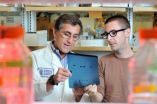(Press-News.org) Pasadena, CA— Water really is everywhere. A team of astronomers have found the largest and farthest reservoir of water ever detected in the universe—discovered in the central regions of a distant quasar. Quasars contain massive black holes that are steadily consuming a surrounding disk of gas and dust; as it eats, the quasar spews out huge amounts of energy. The energy from this particular quasar was released some 12 billion years ago, only 1.6 billion years after the Big Bang and long before most of the stars in the disk of our Milky Way galaxy began forming.
The research team includes Carnegie's Eric Murphy, as well as scientists from the Jet Propulsion Laboratory, the California Institute of Technology, University of Maryland, University of Colorado, University of Pennsylvania, and the Institute for Space and Astronautical Science in Japan. Their research will be published in Astrophysical Journal Letters.
The quasar's newly discovered mass of water exists in gas, or vapor, form. It is estimated to be at least 100,000 times the mass of the Sun, equivalent to 34 billion times the mass of the Earth or 140 trillion times the mass of water in all of Earth's oceans put together.
Since astronomers expected water vapor to be present even in the early universe, the discovery of water is not itself a surprise. There is water vapor in the Milky Way, although the amount is 4,000 times less massive than in the quasar. There is other water in the Milky Way, but it is frozen and not vaporous.
Nevertheless water vapor is an important trace gas that reveals the nature of the quasar. In this particular quasar, the water vapor is distributed around the black hole in a gaseous region spanning hundreds of light years in size (a light year is about six trillion miles). The gas is unusually warm and dense by astronomical standards. It is five-times hotter and 10- to 100-times denser than what is typical in galaxies like the Milky Way.
The large quantity of water vapor in the quasar indicates that it is bathing the gas in both X-rays and infrared radiation. The interaction between the radiation and water vapor reveals properties of how the gas is influenced by the quasar. For example, analyzing the water vapor shows how the radiation heats the rest of the gas. Furthermore, measurements of the water vapor and of other molecules, such as carbon monoxide, suggest that there is enough gas to enable the black hole to grow to about six times its size. Whether or not this has happened is unclear, the astronomers say, since some of the gas could condense into stars or being ejected from the quasar.
A major new telescope in the design phase called CCAT will allow astronomers to measure the abundance of water vapor in many of the early Universe's galaxies.
###
Funding for Z-Spec was provided by NSF, NASA, the Research Corporation, and the partner institutions. The Caltech Submillimiter Observatory is operated by the California Institute of Technology under a contract from the NSF. CARMA was built and is operated by a consortium of universities—The California Institute of Technology, University of California Berkeley, University of Maryland College Park, University of Illinois Urbana-Champaign, and the University of Chicago—with funding from a combination of state and private sources, as well as the NSF and its University Radio Observatory program.
The Carnegie Institution for Science (carnegiescience.edu) is a private, nonprofit organization headquartered in Washington, D.C., with six research departments throughout the U.S. Since its founding in 1902, the Carnegie Institution has been a pioneering force in basic scientific research. Carnegie scientists are leaders in plant biology, developmental biology, astronomy, materials science, global ecology, and Earth and planetary science.
Earliest watery black hole discovered
2011-07-25
ELSE PRESS RELEASES FROM THIS DATE:
Can feeling too good be bad? Positive emotion in bipolar disorder
2011-07-25
Positive emotions like joy and compassion are good for your mental and physical health, and help foster creativity and friendship. But people with bipolar disorder seem to have too much of a good thing. In a new article to be published in the August issue of Current Directions in Psychological Science, a journal of the Association for Psychological Science, psychologist June Gruber of Yale University considers how positive emotion may become negative in bipolar disorder.
One of the characteristics of bipolar disorder is the extreme periods of positive mood, or mania. ...
Farthest, largest water mass in universe discovered
2011-07-25
An international team of astronomers led by the California Institute of Technology and involving the University of Colorado Boulder has discovered the largest and farthest reservoir of water ever detected in the universe.
The distant quasar is one of the most powerful known objects in the universe and has an energy output of 1,000 trillion suns -- about 65,000 times that of the Milky Way galaxy. The quasar's power comes from matter spiraling into the central supermassive black hole, estimated at some 20 billion times the mass of our sun, said study leader Matt Bradford ...
Shining a light on the elusive 'blackbody' of energy research
2011-07-25
CHESTNUT HILL, MA (July 22, 2011) – A designer metamaterial has shown it can engineer emitted "blackbody" radiation with an efficiency beyond the natural limits imposed by the material's temperature, a team of researchers led by Boston College physicist Willie Padilla report in the current edition of Physical Review Letters.
A "blackbody" object represents a theorized ideal of performance for a material that perfectly absorbs all radiation to strike it and also emits energy based on the material's temperature. According to this blackbody law, the energy absorbed is equal ...
Life scientists use novel technique to produce genetic map for African Americans
2011-07-25
UCLA life scientists and colleagues have produced one of the first high-resolution genetic maps for African American populations. A genetic map reveals the precise locations across the genome where DNA from a person's father and mother have been stitched together through a biological process called "recombination." This process results in new genetic combinations that are then passed on to the person's children.
The new map will help disease geneticists working to map genetic diseases in African Americans because it provides a more accurate understanding of recombination ...
Cellular stress can induce yeast to promote prion formation
2011-07-25
It's a chicken and egg question. Where do the infectious protein particles called prions come from? Essentially clumps of misfolded proteins, prions cause neurodegenerative disorders, such as mad cow/Creutzfeld-Jakob disease, in humans and animals. Prions trigger the misfolding and aggregation of their properly folded protein counterparts, but they usually need some kind of "seed" to get started.
Biochemists at Emory University School of Medicine have identified a yeast protein called Lsb2 that can promote spontaneous prion formation. This unstable, short-lived protein ...
NASA catches 3 tropical cyclones at 1 time
2011-07-25
It's not often that a satellite can capture an image of more than one tropical cyclone, but the GOES-13 satellite managed to get 3 tropical cyclones in two ocean basins in one image today. Bret and his "sister" Cindy are racing through the North Atlantic, while another area tries to develop far to their south. "Cousin" Dora is still a hurricane in the eastern Pacific.
In infrared image taken on July 22 at 0845 UTC (4:45 a.m. EDT), GOES-13 captured Tropical Depression Bret, Tropical Storm Cindy in the north Atlantic and low pressure area associated with a tropical wave ...
Northwest Forest Plan has unintended benefit – carbon sequestration
2011-07-25
CORVALLIS, Ore. – The Northwest Forest Plan enacted in 1993 was designed to conserve old-growth forests and protect species such as the northern spotted owl, but researchers conclude in a new study that it had another powerful and unintended consequence – increased carbon sequestration on public lands.
When forest harvest levels fell 82 percent on public forest lands in the years after passage of this act, they became a significant carbon "sink" for the first time in decades, absorbing much more carbon from the atmosphere than they released. At the same time, private ...
New target found for nitric oxide's attack on salmonella bacteria
2011-07-25
A new target for nitric oxide has been revealed in studies of how it inhibits the growth of Salmonella. This bacterium is a common cause of food-poisoning.
"Nitric oxide is naturally produced in the nose and the gut and other tissues in the body to ward off infection," explained the senior author of the paper, Dr. Ferric Fang. He is a University of Washington (UW) professor of laboratory medicine, microbiology and medicine.
Nitric oxide – not to be confused with nitrous oxide, the laughing gas in dentists' offices – is similar to the preservatives in hotdogs, Fang ...
2 genetic variations predict second cancers after radiation for children with Hodgkin lymphoma
2011-07-25
A genome-wide association study published in the August issue of Nature Medicine has found two tiny genetic variations that can predict which patients with Hodgkin's lymphoma are most likely to develop radiation-induced second cancers years after treatment. Knowing in advance who is at risk could help physicians tailor treatment to reduce the risks for patients who are most susceptible to long-term damage.
Hodgkin's lymphoma is one of the most treatable cancers, with more than 90 percent of patients surviving after a combination of radiation and chemotherapy. But nearly ...
Graphene's 'quantum leap' takes electronics a step closer
2011-07-25
Writing in the journal Nature Physics, the academics, who discovered the world's thinnest material at The University of Manchester in 2004, have revealed more about its electronic properties.
Research institutes and universities around the world are already looking at ways to build devices such as touch-screens, ultrafast transistors and photodetectors.
Now the research from the creators of the material promises to accelerate that research, and potentially open up countless more electronic opportunities.
The researchers, from the universities of Manchester, Madrid ...




